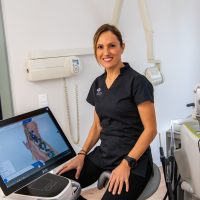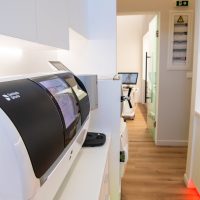Digital dentistry or CAD/CAM dentistry is a field of dentistry and prosthodontics that uses CAD/CAM (computer aided design/computer aided manufacturing) technology to improve the design and production of dental restorations, including crowns, veneers, inlays and onlays, bridges, implant crowns, dentures (removable or fixed) and orthodontic appliances. CAD/CAM technology provides an aesthetic and durable restoration for the patient with an excellent fit. It the speeds up the design procedure, the production and placement of the restoration, which can often be carried out in just one hour.
Computer Aided Design (CAD) and Computer Aided Manufacturing (CAM) is a process where non-digital data is collected, converted into digital form, processed as required and then converted back into physical form with the exact dimensions and materials such as these are determined during the digital design process, usually by either 3D printing or milling. This set of stages is known as the ‘digital workflow’.
Examples of dental restorations that can be fabricated using this system include
- Study casts
- Orthodontic braces
- Inlays and Onlays
- Crowns
- Veneers
- Bridges
- Removable dentures
- Implant crowns
Differences between the CAD/CAM technology and the conventional method for fabricating dental restorations:
- A CAD/CAM restoration is usually created and placed the same day and in many cases in as little as 1 hour. Conventional methods require the placement of temporaries for one to two weeks, while the restoration is produced in the dental laboratory by the dental technician. The patient returns in 1-2 weeks to have the temporaries removed and the final restoration placed and bonded.
- CAD/CAM systems use an optical camera to take a virtual impression of the area while the conventional method requires impression material placed on an impression tray.
- In CAD/CAM systems, the design is done with the help of special software on the computer, while with the conventional method, the design is done by the dental technician in the laboratory.
Procedure
All CAD/CAM systems consist of a computer-aided design (CAD) and computer-aided manufacturing (CAM) stage.
The main stages can generally be summarized as the following:
- Optical Scanning that can capture and record the patient’s intraoral condition.
- Use of software that can convert the captured images into a digital model upon on which a dental restoration can be designed and prepared for fabrication.
- Instructions to devices for converting the design into a product through 3D printing or milling depending on the CAD/CAM system used.
Smile Again
In more detail
For a simple case (crown , inlay, inlay, bridge, implant crown), after the caries is removed or a broken tooth is shaped, the dentist carefully designs the margins of the area of the tooth, a virtual impression is then created of the prepared tooth, the surrounding teeth and tissues with the aid of a scanner.
These images are then converted into a digital model and with the help of software, the restoration is created virtually. At this point the dentist can intervene and make corrections to the shape for a better result. The software then sends this data to a milling (cutting) or printing machine where the 3D design is converted into the final restoration. This can then be glazed and colored to create a more natural effect and depending on the material used can be placed or not in the oven for the final shintering and crystallization.
The restoration is then fitted to the patient’s mouth and bonded.
At DENTAL PEARLS we use the SIRONA CEREC system
- First, the digital impression is taken with the Cerec Primescan intraoral scanner that reconstructs 50,000 images/s. ensuring imaging with a depth of field of 20mm, speed and convenience.
- This is followed by the designing of the restoration with the Cerec software, where the dentist use a variety of parameters to ensure the best fit in the mouth.
- The Cerec Primemill milling machine is then instructed to “cut” the restoration with particular speed and precision.
- The final stage is crystalizing and/or polishing in the Cerec speed fire furnace for single restorations or bridges.
Appointments are usually completed in one session WITHOUT a second visit, leaving the doctor and patients delighted with the procedure and the result.




